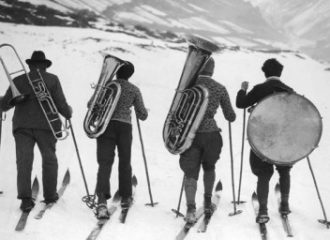Musicians injuries are similar to Keyboarding injuries where musculoskeletal problems are abundant Musicians can benefit a great deal from ergonomics. Whether it is a wind, string or percussion instrument, all instruments require a great deal of repetitive motion to learn to play. They also require proper body mechanics to play well. Knowledge of ergonomics and its relationship to musical instruments can benefit any musician. Good posture is the key to good health. It is doubly important for musicians. Not only is posture needed to keep the body aligned, it is also needed to allow for proper body mechanics while playing. These postures have been developed over centuries, and while not always ergonomically perfect, they are very good at allowing the fingers, hands and arms to perform the necessary task efficiently. Repetitive Stress Injuries are almost a given to the musician. Tendonitis, Bursitis, Carpal Tunnel Syndrome, Back, Neck and Shoulder Pain and Calluses are just some of the possibilities. If you play for any length of time, whether a professional or hobbyist, you will most likely suffer from some level of repetitive stress sometime.
We treat our musicians as athletes. Click here for more information.
- Muscle, bone, tendon, joints, ligaments, nerves, blood vessels and related soft tissues are involved with Musicians Injuries
- Catch-all terms (RSI, CTDs, WRMSDs)
- 50% of all musicians have hand related injuries
- It can limit, interrupt or end a career
Signs and symptoms
- Swelling
- Redness
- Difficulty moving joint
- Loss of motor control
- Numbness
- Tingling
- Pain
- Pain
- Unique for each individual
- High threshold in performers
- Performers normalize pain
- No pain, no performance
- Fear label ‘Musician with injury’
- Lack of resources to subsidize and prevent early treatment
Pain
- Defensive mechanism intended to protect
- May not appear during activity responsible
- May occur during sleep
- May appear suddenly or gradually over months
- Pay attention to when? how long?
- Influence on ability to perform ADLs?
Level 1: Pain occurs after class, practice, rehearsal or performance, but the musician performs normally
Level 2 :Pain occurs during class, practice, rehearsal or performance, but the musician is not restricted in performing
Level III: Pain occurs during class, practice, rehearsal or performance, and begins to affect some aspects of daily life. Musician alters technique duration.
Level IV: Pain occurs as soon as the musician participates in class, practice, rehearsal, or performance , and is too severe to continue. Many aspects of daily life are affected.
Level V: Pain is continuous during all activities of daily life, and the musician is unable to participate in class, practice, rehearsal, or performance.
Focal dystonia
Malfunction of muscle at a specific location resulting in:
- Cramping
- Involuntary flexing or straightening of the joint
- Sense of fatigue
- Loss of coordination
- May or may not be painful
- Referred pain with cramping& spasm
- Interferes with ability to play
Focal dystonia in Upper Extremity typically affects :
Hands & fingers of string and keyboard players
Keyboard & guitar players
- Straining small hand muscles
- Lateral finger movement& finger spread
- Stress on finger flexors at large MCPs (knuckles)
- Loud repeated octaves or chords
String players
- Left wrist flexors (pressure on strings)
- Extensors of right wrist while bowing
- Small rapid bow movements
- Sustained rapid tremelo causes demands on flexors & extensors
Certain wind instruments:
- Oboe
- French horn
- French horn
- Require sustained extension to hold instrument while allowing fingers to curl into position for fingering.
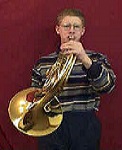
De Quervain’s tenosynovitis
- Pain in tendons at base of thumb& thumb side of forearm
- Painful to move thumb away from hand
- Painful firm grip or twisting motion
- Oboe players
- Clarinet, flute players use thumb extensors to support instrument
- Drummers extreme flexion & lateral motion of wrist with rapid deceleration at impact
- Keyboard& thumb under ascension
- Epicondyle at elbow is anchor point for several muscles
- Pain occurs at elbow, forearm
Medial epicondylitis (golfer’s elbow) occurs due to
- Musicians’ complex postures
- Forearm rotation
- Bending wrist with independent finger movement
- It occurs in keyboard, percussion, clarinet, harp, oboe, trombone players
Rotator cuff tendinitis
- Tendons of several muscles that stabilize arm at the shoulder
- Due to raised shoulder outward or forward shoulder in
- Violin, viola, cello,
- String bass
- Bassoon
Pain in Shoulder:
- usually at top or front of shoulder
- at outer part of arm
- at night, especially when sleeping on the shoulder
Upper back & neck injury
Often occurs due to:
- Postures required to support instrument
- Strength required to support or play larger instruments (double bass, bassoon)
- Static head position →face & neck pain (viola & violin)
- Turning head to one side (flute & harp)
- Tilting head downward (sax & keyboard)
- Methods of transporting & carrying
Carpal tunnel syndrome
- Numbness, tingling & or pain in thumb, index, middle finger
- Due to compression of nerves, blood vessels, tendons
- Due to activities requiring repetitive sustained wrist flexion with a lot of finger movement
- Left hand of violinists, violists, guitar players (12 or 13th position too long)
Cubital tunnel syndrome
- Compression of nerve at ulnar side of elbow
- Numbness, tingling pain or loss of coordination in 4th & 5th fingers.
- Pain at elbow
- Due to postures requiring flexion at elbow& wrist with rotation of palm upward
- Left hand of violinists, violists, guitar players

Thoracic outlet syndrome
- Thoracic outlet syndrome
- Compression of group of nerves (and or blood vessels) travelling toward the arm between the 1rst rib and collarbone
- Shoulders that are rounded, forward& elevated
- Sustained use of pectoral muscles
- Breath holding & irregular breathing patterns
Thoracic outlet syndrome
- Violinists, violists on left side (securing instrument between chin and shoulder)
- Guitar players on left side
- Flute players both sides (flexing shoulders forward, reaching left arm across body, controlling breathing)
- Keyboard (rounded shoulders, arms forward, head forward, irregular breathing patterns)
Risk Factors
| Envoirment aspects | Physical demands | Personal characteristics |
| Temperature | Awkward postures | Age & gender |
| Confined space | Forceful exertion | Physical fitness (strength, flexibility, endurance) |
| Layout of space | Repetition | Nutrition |
| Equipment | Long-duration activities (inadequate rest) | Posture |
| Layout or configuration of equipment | Contact stress (sharp edges) | Addictive substances (tobacco, alcohol, narcotics) |
| Surfaces (floors) | Vibration | Psychological stress |
| lightning | Diseases or health conditions (pregnancy, diabetes,osteoporosis) |
Influences on risk of injury in musicians
Administrative
|
Artistic
|
Technical
|
|
Venue design
|
Musican Injuries |
Early development
|
Risk factors
- A change in technique or instrument
- Intense preparation for performance
- Overly strenuous repetition of demanding musical phrases
- Sudden increase in duration or intensity
- Preparation of a new or difficult piece
- Prolonged performance without adequate rest
- Lack of warm up
- Combination
- Challenging schedule
- Poor diet
- Pressure to perfect
- Performance anxiety
Prevention
Level 1-Controlling risk factors
- Developing& adhering to warm up routine
- Rest breaks that leave you feeling refreshed
- Longer rest breaks require another warm up
- Gradual increases to the duration and intensity of practice
Level 2-Recognizing signs& symptoms and responding appropriately
- Musician has most control during practice sessions
- Focus on practice habits but also implement prevention during rehearsals & performances when possible
- Maintain personal health, fitness and nutrition
- Carry and set up equipment safely
- Maintain body awareness
- Know your limits (balance physical & psychological demands)
- Adjust practice schedules
- Vary difficulty of music
- Good playing technique
- Select appropriate instruments and furniture
Maintain personal health, fitness and nutrition in all aspects of daily living
- Nutrition
- Hydration
- Physical activity
- Sleep quality
- Stress management
- Smoking, alcohol, coffee, drugs decrease blood flow, interfere with normal nerve function, alter judgment, decision making
Select appropriate practice location
- Cold
- blood flow to fingers
- lubrication tendons & joints
- nerve conduction velocity
- Poor lighting
- Compromises ability to read music
- Compromises playing posture
- Eye strain
Select properly heated & well lit environment
- Use portable task lamps, battery powered clip lights
- Regular eye exam & corrective eye wear
- Adequate clothing
- Warm hands
- Fingerless gloves, whole body exercise
Develop good practice habits
- Warm up
- blood flow
- Warms muscles and joints
- 2 components: Joint rotation & aerobic warm up
- Gentle smooth motions x several minutes
- Gentle smooth motions x several minutes
- Slow long notes beginning practice, rehearsal, performance
- Gradual increase to duration& intensity of practice
- Stretching controversial
- Seek medical advice on proper techniques
- Nerve glides
Taking rest breaks
- Mitigates stress (physical & psychological)
- Allows physical recovery of tissues
- May enhance learning
- Avoids muscle fatigue
- Schedule rest breaks into practice session
- 5 min rest for 25 minutes playing
- 10 min rest for 50 min playing
- 10-15 min rest for 30 min playing
- Spread practice time throughout the day
Avoid repetition
- Variety of music & exercises
- Build in time for simpler pieces
- Use imaging and visualization
- Note by note
- Movement by movement
- Assists cognitive aspects of learning
- Enhances speed of motor learning
- Reduces physical practice time & physical risk of injury
Select appropriate instruments
- Well maintained and well designed
- Avoid leaky valves or pads
- Avoid bridges that are too high
- Avoid excess dead space at top of piano keys
- Instrument that fits the musician
Selecting and adjusting furniture
- Chairs & stools adjusted so feet flat on floor
- Chair too short and not adjustable?
- Add a cushion
- Stack chairs
- Chair Extensions under chair feet (see therapy catalogs)
- Chair too tall?
- Footrest (phonebook)
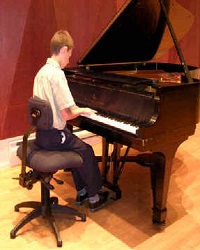
Sitting posture
- Depends on instrument
- Maintain low back curve
- Lumbar pillow
- Wedge cushion
- Foot width
- Wide base
- Feet in front of knees
- Vary position
For wind players posture plays a very important role. Holding a good posture, with your instrument properly held, opens up the chest cavity allowing for good breathing.
It is important to keep in mind that sitting and standing postures are different.
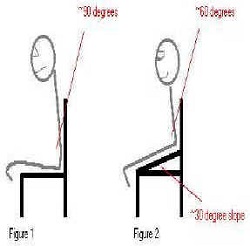
Selecting and adjusting furniture
- Adjust music stands
- Sheet music at eye level or below
- Lower eyes rather than head
- Directly in front when playing
Prevention-various gadgets
There are a number of non-traditional instrument designs available on the market or custom made. If you are serious about music and your health, then you should seriously consider these options. An instruments shape and key/string layout does not necessarily alter the sound it produces. Engineers and designers have used this fact to adjust a traditional form to provide the same sound while making it easier to play.
-
Prevention-Harnesses
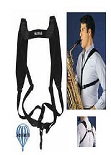
-
Guitar straps, belts & supports
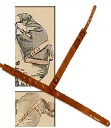
-
Prevention-Stands
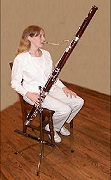
-
Various gadgets
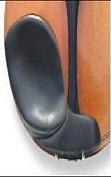
High chin rests (violins, violas)
Carry and set up equipment safely
- Plan lift
- Avoid twisting & rapid lifting
- How heavy is load?
- Stable base
- Face item
- Solid grip
- Clear route AND TAKE YOUR TIME!
Practicing body awareness
- A better sense of posture, movement, status of body →
- ↑ Ability to choose appropriate playing posture
- ↑ fluidity of movement
- ↑ understanding of difference between normal fatigue related discomfort versus pain due to injury
Level 1: recognizing signs& symptoms and administering self-help techniques
Level 2: recognizing when signs & symptoms are persisitent& unusual then seeking professional medical help Warning signs& symptoms
- Discomfort, pain, tingling, numbness while playing
- Weakness in hands or difficulty with fine control of fingers
- Stiffness
- Postural changes (elevated and or rounded shoulders)
- Local swelling or roundness
- DO NOT PLAY THROUGH PAIN
Initial Treatment
- REST
- ICE
- ↓ Blood flow & sensation
- 10 minutes
- Not directly on skin (frozen peas in damp towel)
- No creams, balms, rubs
- Do not use to numb pain to keep performing
- COMPRESSION (ask health professional)
- ELEVATION (above level of heart)
When to seek medical assistance
- Symptoms occur each time you play
- Symptoms continue to worsen
- Symptoms unusual for you
- Symptoms persist after practicing
- Symptoms occur at other times i.e. during sleep
- Seek health care professional experienced in treating musicians
Multidisciplinary approach
- Musician
- Health care providers
- Teachers
- Equipment providers
- Instrument providers
- Furniture providers
Reminders
- Identify aspects of set up, practice habits, playing posture at fault
- Increase rest, decrease continuous playing (until you play without symptoms)
- Gradual smooth warm up
- Be aware of passages contributing to signs& symptoms then reduce intensity& level of reps
- Perform long slow notes, simpler passages following complex passages
- Alternate physical practice with mental practice
Bottom line, treat every musician like an athlete, thus building core muscles, improving endurance thus improving performance and preventing injuries.


